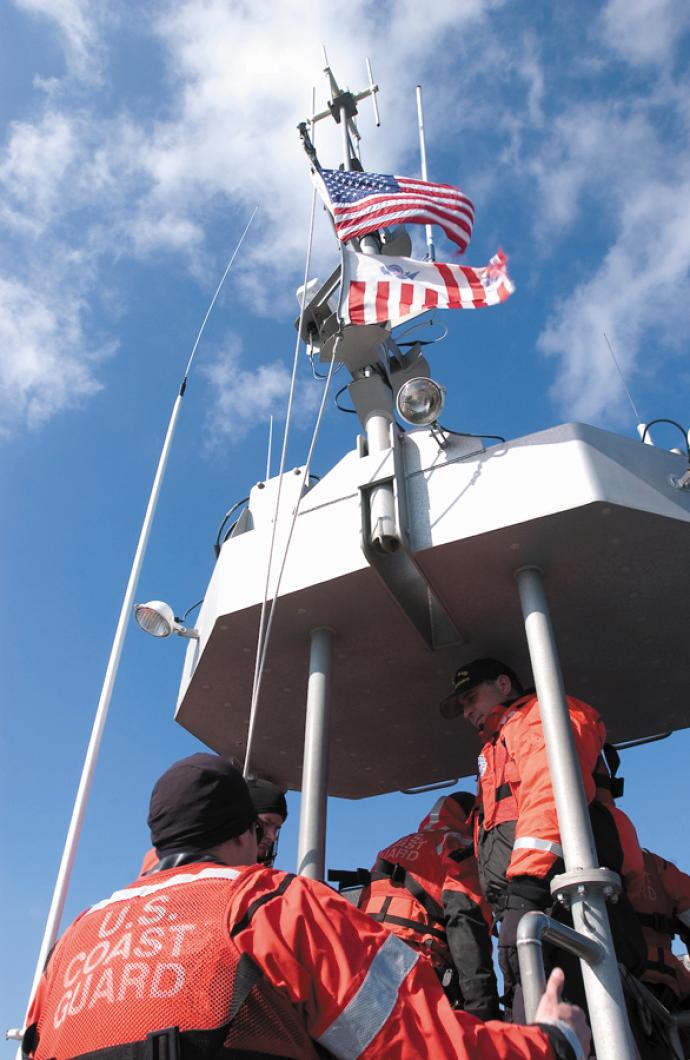On a blustery, cold February day, the 47-foot Coast Guard motor lifeboat out of Menemsha pitched and rolled in Vineyard Sound. Strong, chilly winds coming up from the southwest had kicked up big swells off Menemsha Bight to nine feet and off Quick’s Hole to 12 feet.
On board the vessel, Senior Chief Stephen Barr conducted a training and testing session with his crew. He is in charge at the small station and this afternoon he held a stopwatch in his hand. The men were dressed in orange and black dry-suits which would protect them if at any time they fell into the frigid sea. Their faces were pink from the cold steady breeze.
At times waves crashed over the bow and coated the crew, the windows and the gear on deck. Inside, the air was dry and warm.
The only visual object that wasn’t moving was the horizon and the hills of Naushon, Pasque and Nashawena Islands to the north and to the east and south the Vineyard’s northern shore.
“This is routine for us,” said the senior chief, above the hum and rumble of two Detroit diesels spinning over 1,450 revolutions a minute, the engines hidden from view by two separate watertight bulkhead hatches.
So much of the emphasis within the Coast Guard is training, the senior chief said. On this afternoon, the aluminum 47-foot motor lifeboat ran perfectly, though huge waves sped past her like a stampede of wild horses.
A day later, on Wednesday night, Mr. Barr stood on firm ground comfortably wearing a white shirt and blue trowsers before an audience, at a sold-out dinner at the Black Dog Tavern.
Mr. Barr, the featured speaker, talked about the Coast Guard and its new expanded role since it came under the Department of Homeland Security after the terrorist attacks of Sept. 11, 2001.
The evening talk was hosted by Sail Martha’s Vineyard, a nonprofit Island organization committed to offering Island youngsters free safe boat handling instruction during the summer. In more recent years the organization has expanded its mission to offer adult programs.
His station, like the rest of the service, has a full plate. They all wear multiple hats: saving lives through rescue, saving lives by promoting and enforcing boating safety, enforcing fisheries regulations and keeping the waters secure.
Mr. Barr talked about the Coast Guard’s many different crafts and aircraft that are charged with serving the waters from the East Coast to the West Coast and beyond.
His presentation included a slide show that included pictures of the Coast Guard’s big rescues over the last decade. There were pictures of white water, ships sinking and men swimming helplessly.
A day earlier, on Tuesday afternoon, Mr. Barr’s crew could taste the saltwater on their lips when they conducted simulated rescues of a man overboard in the high seas.
A rubber dummy was tossed off the stern. Then the crew started yelling, shouting, “Man overboard.” Loud verbal commands followed.
Mark Chaknis, the man at the helm, turned the vessel. Waves passing by the boat all of a sudden rose up and hit the boat broadside. The senior chief watched his stopwatch, as the men went about the rescue. Their clothes were covered with seawater after they pulled the dummy out of the water.
The Coast Guardsmen performed the exercise twice before bringing the boat back to the still waters of Menemsha harbor.
A day later, standing in the Black Dog Tavern before 65 people, with a few turned away, Mr. Barr spoke about the high degree of training his men receive.
“The Coast Guard rescues that followed Hurricane Katrina are a perfect example,” the senior chief said. Coast Guardsmen from around the country were sent to the storm-wrecked area. Everyone from airmen to rescue swimmers and boat crews were brought together to work together and save people’s lives.
The vocabulary, the tools and the training are the same. “We all speak the same language no matter what part of the country we come from,” the senior chief said.
The effort worked well because everyone participating in the rescue was familiar with the equipment, the mission and knew how to do it efficiently. “The training at the station in Chilmark is no different from what is offered at other stations throughout the country,” Mr. Barr said.
Twenty Coast Guardsmen are working at the Menemsha Station this winter. It is not as many as the station needs to operate easily 24 hours a day, but it is adequate enough to do the job right, the senior chief said.
Prior to his time, the station has had as few as 11 people and as many as 29.
Technology has raised the level of service at the station. The 40-foot tall radio tower on top of Peaked Hill can pick up any distress call in the region 24 hours a day, whether the radioman is on at the Menemsha station or it is sitting at a desk in Woods Hole.
Last year the station handled 40 cases.
As remote as the Menemsha Coast Guard station might be in relation to mainland stations, Senior Chief Barr said his crew has already earned accolades for their preparedness. Last month the station received the Sumner I. Kimball Readiness Award. The award is given within the Coast Guard to recognize those stations that demonstrate highest levels of preparedness.
Rear Admiral Tim Sullivan, who heads the region as commander, Coast Guard First District, delivered the award.
“I absolutely enjoyed giving the talk,” Senior Chief Barr said after his presentation. “This is community outreach for us, which makes us successful. It is our job to work with the community. We rely on the community and its support.”




Comments
Comment policy »